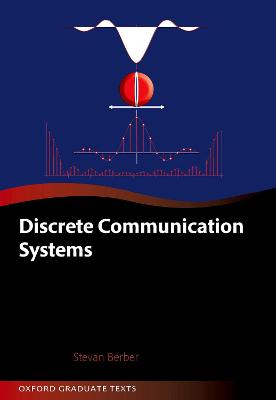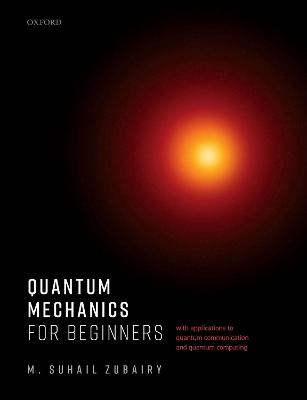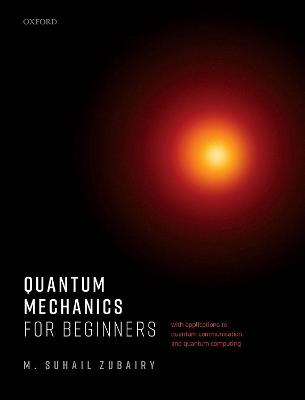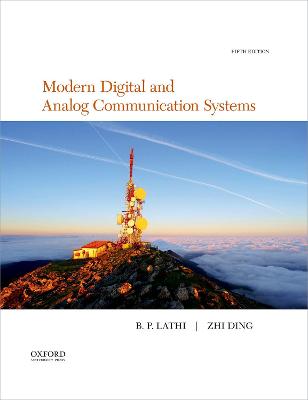Signal Processing and Linear Systems
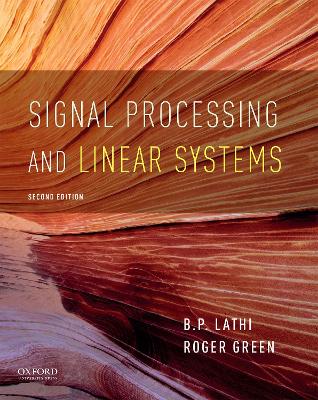 -10%
portes grátis
-10%
portes grátis
Signal Processing and Linear Systems
Lathi; Green
Oxford University Press Inc
02/2021
1152
Dura
Inglês
9780190299040
15 a 20 dias
Descrição não disponível.
Chapter B: Background
B.1 Complex Numbers
B.2 Sinusoids
B.3 Sketching Signals
B.4 Cramer's Rule
B.5 Partial Fraction Expansion
B.6 Vectors and Matrices
B.7 MATLAB: Elementary Operations
B.8 Appendix: Useful Mathematical Formulas
Chapter 1: Signals and Systems
1.1 Size of a Signal
1.2 Some Useful Signal Operations
1.3 Classification of Signals
1.4 Some Useful Signal Models
1.5 Even and Odd Functions
1.6 Systems
1.7 Classification of Systems
1.8 System Model: Input-Output Description
1.9 Internal and External Descriptions of a System
1.10 Internal Description: The State-Space Description
1.11 MATLAB: Working with Functions
1.12 Summary
Chapter 2: Time-Domain Analysis of Continuous-Time Systems
2.1 Introduction
2.2 System Response to Internal Conditions: The Zero-Input Response
2.3 The Unit Impulse Response h(t)
2.4 System Response to External Input: The Zero-State Response
2.5 System Stability
2.6 Intuitive Insights into System Behavior
2.7 MATLAB: M-Files
2.8 Appendix: Determining the Impulse Response
2.9 Summary
Chapter 3: Signal Representation by Fourier Series
3.1 Signals as Vectors
3.2 Signal Comparison: Correlation
3.3 Signal Representation by an Orthogonal Signal Set
3.4 Trigonometric Fourier Series
3.5 Existence and Convergence of the Fourier Series
3.6 Exponential Fourier Series
3.7 LTIC System Response to Periodic Inputs
3.8 Numerical Computation of Dn
3.9 MATLAB: Fourier Series Applications
3.10 Summary
Chapter 4: Continuous-Time Signal Analysis: The Fourier Transform
4.1 Aperiodic Signal Representation by the Fourier Integral
4.2 Transforms of Some Useful Functions
4.3 Some Properties of the Fourier Transform
4.4 Signal Transmission Through LTIC Systems
4.5 Ideal and Practical Filters
4.6 Signal Energy
4.7 Application to Communications: Amplitude Modulation
4.8 Angle Modulation
4.9 Data Truncation: Window Functions
4.10 MATLAB: Fourier Transform Topics
4.11 Summary
Chapter 5: Sampling
5.1 The Sampling Theorem
5.2 Signal Reconstruction
5.3 Analog-to-Digital (A/D) Conversion
5.4 Dual of Time Sampling: Spectral Sampling
5.5 Numerical Computation of the Fourier Transform: The Discrete Fourier Transform
5.6 The Fast Fourier Transform (FFT)
5.7 MATLAB: The Discrete Fourier Transform
5.8 Summary
Chapter 6: Continuous-Time System Analysis Using the Laplace Transform
6.1 The Laplace Transform
6.2 Some Properties of the Laplace Transform
6.3 Solution of Differential and Integro-Differential Equations
6.3.4 Inverse Systems
6.4 Analysis of Electrical Networks: The Transformed Network
6.5 Block Diagrams
6.6 System Realization
6.7 Application to Feedback and Controls
6.8 The Bilateral Laplace Transform
6.9 Summary
Chapter 7: Frequency Response and Analog Filters
7.1 Frequency Response of an LTIC System
7.2 Bode Plots
7.3 Control System Design Using Frequency Response
7.4 Filter Design by Placement of Poles and Zeros of H(s)
7.5 Butterworth Filters
7.6 Chebyshev Filters
7.7 Frequency Transformations
7.8 Filters to Satisfy Distortionless Transmission Conditions
7.9 MATLAB: Continuous-Time Filters
7.10 Summary
Chapter 8: Discrete-Time Signals and Systems
8.1 Introduction
8.2 Useful Signal Operations
8.3 Some Useful Discrete-Time Signal Models
8.4 Aliasing and Sampling Rate
8.5 Examples of Discrete-Time Systems
8.6 MATLAB: Representing, Manipulating, and Plotting Discrete-Time Signals
8.7 Summary
Chapter 9: Time-Domain Analysis of Discrete-Time Systems
9.1 Classification of Discrete-Time Systems
9.2 Discrete-Time System Equations
9.3 System Response to Internal Conditions: The Zero-Input Response
9.4 The Unit Impulse Response h[n]
9.5 System Response to External Input: The Zero-State Response
9.6 System Stability
9.7 Intuitive Insights into System Behavior
9.8 MATLAB: Discrete-Time Systems
9.9 Appendix: Impulse Response for a Special Case
9.10 Summary
Chapter 10: Fourier Analysis of Discrete-Time Signals
10.1 Periodic Signal Representation by Discrete-Time Fourier Series
10.2 Aperiodic Signal Representation by Fourier Integral
10.3 Properties of the DTFT
10.4 DTFT Connection with the CTFT
10.5 LTI Discrete-Time System Analysis by
10.6 Signal Processing by the DFT and FFT
10.7 Generalization of the DTFT to the z-Transform
10.8 MATLAB: Working with the DTFS and the DTFT
10.9 Summary
Chapter 11: Discrete-Time System Analysis Using the z-Transform
11.1 The z-Transform
11.2 Some Properties of the z-Transform
11.3 z-Transform Solution of Linear Difference Equations
11.4 System Realization
11.5 Connecting the Laplace and z-Transforms
11.6 Sampled-Data (Hybrid) Systems
11.7 The Bilateral z-Transform
11.8 Summary
Chapter 12: Frequency Response and Digital Filters
12.1 Frequency Response of Discrete-Time Systems
12.2 Frequency Response from Pole-Zero Locations
12.3 Digital Filters
12.4 Filter Design Criteria
12.5 Recursive Filter Design: The Impulse Invariance Method
12.6 Recursive Filter Design: The Bilinear Transformation Method
12.7 Nonrecursive Filters
12.8 Nonrecursive Filter Design
12.9 MATLAB: Designing High-Order Filters
12.10 Summary
Chapter 13: State-Space Analysis
13.1 Mathematical Preliminaries
13.2 Introduction to State Space
13.3 A Systematic Procedure to Determine State Equations
13.4 Solution of State Equations
13.5 Linear Transformation of a State Vector
13.6 Controllability and Observability
13.7 State-Space Analysis of Discrete-Time Systems
13.8 MATLAB: Toolboxes and State-Space Analysis
13.9 Summary
B.1 Complex Numbers
B.2 Sinusoids
B.3 Sketching Signals
B.4 Cramer's Rule
B.5 Partial Fraction Expansion
B.6 Vectors and Matrices
B.7 MATLAB: Elementary Operations
B.8 Appendix: Useful Mathematical Formulas
Chapter 1: Signals and Systems
1.1 Size of a Signal
1.2 Some Useful Signal Operations
1.3 Classification of Signals
1.4 Some Useful Signal Models
1.5 Even and Odd Functions
1.6 Systems
1.7 Classification of Systems
1.8 System Model: Input-Output Description
1.9 Internal and External Descriptions of a System
1.10 Internal Description: The State-Space Description
1.11 MATLAB: Working with Functions
1.12 Summary
Chapter 2: Time-Domain Analysis of Continuous-Time Systems
2.1 Introduction
2.2 System Response to Internal Conditions: The Zero-Input Response
2.3 The Unit Impulse Response h(t)
2.4 System Response to External Input: The Zero-State Response
2.5 System Stability
2.6 Intuitive Insights into System Behavior
2.7 MATLAB: M-Files
2.8 Appendix: Determining the Impulse Response
2.9 Summary
Chapter 3: Signal Representation by Fourier Series
3.1 Signals as Vectors
3.2 Signal Comparison: Correlation
3.3 Signal Representation by an Orthogonal Signal Set
3.4 Trigonometric Fourier Series
3.5 Existence and Convergence of the Fourier Series
3.6 Exponential Fourier Series
3.7 LTIC System Response to Periodic Inputs
3.8 Numerical Computation of Dn
3.9 MATLAB: Fourier Series Applications
3.10 Summary
Chapter 4: Continuous-Time Signal Analysis: The Fourier Transform
4.1 Aperiodic Signal Representation by the Fourier Integral
4.2 Transforms of Some Useful Functions
4.3 Some Properties of the Fourier Transform
4.4 Signal Transmission Through LTIC Systems
4.5 Ideal and Practical Filters
4.6 Signal Energy
4.7 Application to Communications: Amplitude Modulation
4.8 Angle Modulation
4.9 Data Truncation: Window Functions
4.10 MATLAB: Fourier Transform Topics
4.11 Summary
Chapter 5: Sampling
5.1 The Sampling Theorem
5.2 Signal Reconstruction
5.3 Analog-to-Digital (A/D) Conversion
5.4 Dual of Time Sampling: Spectral Sampling
5.5 Numerical Computation of the Fourier Transform: The Discrete Fourier Transform
5.6 The Fast Fourier Transform (FFT)
5.7 MATLAB: The Discrete Fourier Transform
5.8 Summary
Chapter 6: Continuous-Time System Analysis Using the Laplace Transform
6.1 The Laplace Transform
6.2 Some Properties of the Laplace Transform
6.3 Solution of Differential and Integro-Differential Equations
6.3.4 Inverse Systems
6.4 Analysis of Electrical Networks: The Transformed Network
6.5 Block Diagrams
6.6 System Realization
6.7 Application to Feedback and Controls
6.8 The Bilateral Laplace Transform
6.9 Summary
Chapter 7: Frequency Response and Analog Filters
7.1 Frequency Response of an LTIC System
7.2 Bode Plots
7.3 Control System Design Using Frequency Response
7.4 Filter Design by Placement of Poles and Zeros of H(s)
7.5 Butterworth Filters
7.6 Chebyshev Filters
7.7 Frequency Transformations
7.8 Filters to Satisfy Distortionless Transmission Conditions
7.9 MATLAB: Continuous-Time Filters
7.10 Summary
Chapter 8: Discrete-Time Signals and Systems
8.1 Introduction
8.2 Useful Signal Operations
8.3 Some Useful Discrete-Time Signal Models
8.4 Aliasing and Sampling Rate
8.5 Examples of Discrete-Time Systems
8.6 MATLAB: Representing, Manipulating, and Plotting Discrete-Time Signals
8.7 Summary
Chapter 9: Time-Domain Analysis of Discrete-Time Systems
9.1 Classification of Discrete-Time Systems
9.2 Discrete-Time System Equations
9.3 System Response to Internal Conditions: The Zero-Input Response
9.4 The Unit Impulse Response h[n]
9.5 System Response to External Input: The Zero-State Response
9.6 System Stability
9.7 Intuitive Insights into System Behavior
9.8 MATLAB: Discrete-Time Systems
9.9 Appendix: Impulse Response for a Special Case
9.10 Summary
Chapter 10: Fourier Analysis of Discrete-Time Signals
10.1 Periodic Signal Representation by Discrete-Time Fourier Series
10.2 Aperiodic Signal Representation by Fourier Integral
10.3 Properties of the DTFT
10.4 DTFT Connection with the CTFT
10.5 LTI Discrete-Time System Analysis by
10.6 Signal Processing by the DFT and FFT
10.7 Generalization of the DTFT to the z-Transform
10.8 MATLAB: Working with the DTFS and the DTFT
10.9 Summary
Chapter 11: Discrete-Time System Analysis Using the z-Transform
11.1 The z-Transform
11.2 Some Properties of the z-Transform
11.3 z-Transform Solution of Linear Difference Equations
11.4 System Realization
11.5 Connecting the Laplace and z-Transforms
11.6 Sampled-Data (Hybrid) Systems
11.7 The Bilateral z-Transform
11.8 Summary
Chapter 12: Frequency Response and Digital Filters
12.1 Frequency Response of Discrete-Time Systems
12.2 Frequency Response from Pole-Zero Locations
12.3 Digital Filters
12.4 Filter Design Criteria
12.5 Recursive Filter Design: The Impulse Invariance Method
12.6 Recursive Filter Design: The Bilinear Transformation Method
12.7 Nonrecursive Filters
12.8 Nonrecursive Filter Design
12.9 MATLAB: Designing High-Order Filters
12.10 Summary
Chapter 13: State-Space Analysis
13.1 Mathematical Preliminaries
13.2 Introduction to State Space
13.3 A Systematic Procedure to Determine State Equations
13.4 Solution of State Equations
13.5 Linear Transformation of a State Vector
13.6 Controllability and Observability
13.7 State-Space Analysis of Discrete-Time Systems
13.8 MATLAB: Toolboxes and State-Space Analysis
13.9 Summary
Este título pertence ao(s) assunto(s) indicados(s). Para ver outros títulos clique no assunto desejado.
Chapter B: Background
B.1 Complex Numbers
B.2 Sinusoids
B.3 Sketching Signals
B.4 Cramer's Rule
B.5 Partial Fraction Expansion
B.6 Vectors and Matrices
B.7 MATLAB: Elementary Operations
B.8 Appendix: Useful Mathematical Formulas
Chapter 1: Signals and Systems
1.1 Size of a Signal
1.2 Some Useful Signal Operations
1.3 Classification of Signals
1.4 Some Useful Signal Models
1.5 Even and Odd Functions
1.6 Systems
1.7 Classification of Systems
1.8 System Model: Input-Output Description
1.9 Internal and External Descriptions of a System
1.10 Internal Description: The State-Space Description
1.11 MATLAB: Working with Functions
1.12 Summary
Chapter 2: Time-Domain Analysis of Continuous-Time Systems
2.1 Introduction
2.2 System Response to Internal Conditions: The Zero-Input Response
2.3 The Unit Impulse Response h(t)
2.4 System Response to External Input: The Zero-State Response
2.5 System Stability
2.6 Intuitive Insights into System Behavior
2.7 MATLAB: M-Files
2.8 Appendix: Determining the Impulse Response
2.9 Summary
Chapter 3: Signal Representation by Fourier Series
3.1 Signals as Vectors
3.2 Signal Comparison: Correlation
3.3 Signal Representation by an Orthogonal Signal Set
3.4 Trigonometric Fourier Series
3.5 Existence and Convergence of the Fourier Series
3.6 Exponential Fourier Series
3.7 LTIC System Response to Periodic Inputs
3.8 Numerical Computation of Dn
3.9 MATLAB: Fourier Series Applications
3.10 Summary
Chapter 4: Continuous-Time Signal Analysis: The Fourier Transform
4.1 Aperiodic Signal Representation by the Fourier Integral
4.2 Transforms of Some Useful Functions
4.3 Some Properties of the Fourier Transform
4.4 Signal Transmission Through LTIC Systems
4.5 Ideal and Practical Filters
4.6 Signal Energy
4.7 Application to Communications: Amplitude Modulation
4.8 Angle Modulation
4.9 Data Truncation: Window Functions
4.10 MATLAB: Fourier Transform Topics
4.11 Summary
Chapter 5: Sampling
5.1 The Sampling Theorem
5.2 Signal Reconstruction
5.3 Analog-to-Digital (A/D) Conversion
5.4 Dual of Time Sampling: Spectral Sampling
5.5 Numerical Computation of the Fourier Transform: The Discrete Fourier Transform
5.6 The Fast Fourier Transform (FFT)
5.7 MATLAB: The Discrete Fourier Transform
5.8 Summary
Chapter 6: Continuous-Time System Analysis Using the Laplace Transform
6.1 The Laplace Transform
6.2 Some Properties of the Laplace Transform
6.3 Solution of Differential and Integro-Differential Equations
6.3.4 Inverse Systems
6.4 Analysis of Electrical Networks: The Transformed Network
6.5 Block Diagrams
6.6 System Realization
6.7 Application to Feedback and Controls
6.8 The Bilateral Laplace Transform
6.9 Summary
Chapter 7: Frequency Response and Analog Filters
7.1 Frequency Response of an LTIC System
7.2 Bode Plots
7.3 Control System Design Using Frequency Response
7.4 Filter Design by Placement of Poles and Zeros of H(s)
7.5 Butterworth Filters
7.6 Chebyshev Filters
7.7 Frequency Transformations
7.8 Filters to Satisfy Distortionless Transmission Conditions
7.9 MATLAB: Continuous-Time Filters
7.10 Summary
Chapter 8: Discrete-Time Signals and Systems
8.1 Introduction
8.2 Useful Signal Operations
8.3 Some Useful Discrete-Time Signal Models
8.4 Aliasing and Sampling Rate
8.5 Examples of Discrete-Time Systems
8.6 MATLAB: Representing, Manipulating, and Plotting Discrete-Time Signals
8.7 Summary
Chapter 9: Time-Domain Analysis of Discrete-Time Systems
9.1 Classification of Discrete-Time Systems
9.2 Discrete-Time System Equations
9.3 System Response to Internal Conditions: The Zero-Input Response
9.4 The Unit Impulse Response h[n]
9.5 System Response to External Input: The Zero-State Response
9.6 System Stability
9.7 Intuitive Insights into System Behavior
9.8 MATLAB: Discrete-Time Systems
9.9 Appendix: Impulse Response for a Special Case
9.10 Summary
Chapter 10: Fourier Analysis of Discrete-Time Signals
10.1 Periodic Signal Representation by Discrete-Time Fourier Series
10.2 Aperiodic Signal Representation by Fourier Integral
10.3 Properties of the DTFT
10.4 DTFT Connection with the CTFT
10.5 LTI Discrete-Time System Analysis by
10.6 Signal Processing by the DFT and FFT
10.7 Generalization of the DTFT to the z-Transform
10.8 MATLAB: Working with the DTFS and the DTFT
10.9 Summary
Chapter 11: Discrete-Time System Analysis Using the z-Transform
11.1 The z-Transform
11.2 Some Properties of the z-Transform
11.3 z-Transform Solution of Linear Difference Equations
11.4 System Realization
11.5 Connecting the Laplace and z-Transforms
11.6 Sampled-Data (Hybrid) Systems
11.7 The Bilateral z-Transform
11.8 Summary
Chapter 12: Frequency Response and Digital Filters
12.1 Frequency Response of Discrete-Time Systems
12.2 Frequency Response from Pole-Zero Locations
12.3 Digital Filters
12.4 Filter Design Criteria
12.5 Recursive Filter Design: The Impulse Invariance Method
12.6 Recursive Filter Design: The Bilinear Transformation Method
12.7 Nonrecursive Filters
12.8 Nonrecursive Filter Design
12.9 MATLAB: Designing High-Order Filters
12.10 Summary
Chapter 13: State-Space Analysis
13.1 Mathematical Preliminaries
13.2 Introduction to State Space
13.3 A Systematic Procedure to Determine State Equations
13.4 Solution of State Equations
13.5 Linear Transformation of a State Vector
13.6 Controllability and Observability
13.7 State-Space Analysis of Discrete-Time Systems
13.8 MATLAB: Toolboxes and State-Space Analysis
13.9 Summary
B.1 Complex Numbers
B.2 Sinusoids
B.3 Sketching Signals
B.4 Cramer's Rule
B.5 Partial Fraction Expansion
B.6 Vectors and Matrices
B.7 MATLAB: Elementary Operations
B.8 Appendix: Useful Mathematical Formulas
Chapter 1: Signals and Systems
1.1 Size of a Signal
1.2 Some Useful Signal Operations
1.3 Classification of Signals
1.4 Some Useful Signal Models
1.5 Even and Odd Functions
1.6 Systems
1.7 Classification of Systems
1.8 System Model: Input-Output Description
1.9 Internal and External Descriptions of a System
1.10 Internal Description: The State-Space Description
1.11 MATLAB: Working with Functions
1.12 Summary
Chapter 2: Time-Domain Analysis of Continuous-Time Systems
2.1 Introduction
2.2 System Response to Internal Conditions: The Zero-Input Response
2.3 The Unit Impulse Response h(t)
2.4 System Response to External Input: The Zero-State Response
2.5 System Stability
2.6 Intuitive Insights into System Behavior
2.7 MATLAB: M-Files
2.8 Appendix: Determining the Impulse Response
2.9 Summary
Chapter 3: Signal Representation by Fourier Series
3.1 Signals as Vectors
3.2 Signal Comparison: Correlation
3.3 Signal Representation by an Orthogonal Signal Set
3.4 Trigonometric Fourier Series
3.5 Existence and Convergence of the Fourier Series
3.6 Exponential Fourier Series
3.7 LTIC System Response to Periodic Inputs
3.8 Numerical Computation of Dn
3.9 MATLAB: Fourier Series Applications
3.10 Summary
Chapter 4: Continuous-Time Signal Analysis: The Fourier Transform
4.1 Aperiodic Signal Representation by the Fourier Integral
4.2 Transforms of Some Useful Functions
4.3 Some Properties of the Fourier Transform
4.4 Signal Transmission Through LTIC Systems
4.5 Ideal and Practical Filters
4.6 Signal Energy
4.7 Application to Communications: Amplitude Modulation
4.8 Angle Modulation
4.9 Data Truncation: Window Functions
4.10 MATLAB: Fourier Transform Topics
4.11 Summary
Chapter 5: Sampling
5.1 The Sampling Theorem
5.2 Signal Reconstruction
5.3 Analog-to-Digital (A/D) Conversion
5.4 Dual of Time Sampling: Spectral Sampling
5.5 Numerical Computation of the Fourier Transform: The Discrete Fourier Transform
5.6 The Fast Fourier Transform (FFT)
5.7 MATLAB: The Discrete Fourier Transform
5.8 Summary
Chapter 6: Continuous-Time System Analysis Using the Laplace Transform
6.1 The Laplace Transform
6.2 Some Properties of the Laplace Transform
6.3 Solution of Differential and Integro-Differential Equations
6.3.4 Inverse Systems
6.4 Analysis of Electrical Networks: The Transformed Network
6.5 Block Diagrams
6.6 System Realization
6.7 Application to Feedback and Controls
6.8 The Bilateral Laplace Transform
6.9 Summary
Chapter 7: Frequency Response and Analog Filters
7.1 Frequency Response of an LTIC System
7.2 Bode Plots
7.3 Control System Design Using Frequency Response
7.4 Filter Design by Placement of Poles and Zeros of H(s)
7.5 Butterworth Filters
7.6 Chebyshev Filters
7.7 Frequency Transformations
7.8 Filters to Satisfy Distortionless Transmission Conditions
7.9 MATLAB: Continuous-Time Filters
7.10 Summary
Chapter 8: Discrete-Time Signals and Systems
8.1 Introduction
8.2 Useful Signal Operations
8.3 Some Useful Discrete-Time Signal Models
8.4 Aliasing and Sampling Rate
8.5 Examples of Discrete-Time Systems
8.6 MATLAB: Representing, Manipulating, and Plotting Discrete-Time Signals
8.7 Summary
Chapter 9: Time-Domain Analysis of Discrete-Time Systems
9.1 Classification of Discrete-Time Systems
9.2 Discrete-Time System Equations
9.3 System Response to Internal Conditions: The Zero-Input Response
9.4 The Unit Impulse Response h[n]
9.5 System Response to External Input: The Zero-State Response
9.6 System Stability
9.7 Intuitive Insights into System Behavior
9.8 MATLAB: Discrete-Time Systems
9.9 Appendix: Impulse Response for a Special Case
9.10 Summary
Chapter 10: Fourier Analysis of Discrete-Time Signals
10.1 Periodic Signal Representation by Discrete-Time Fourier Series
10.2 Aperiodic Signal Representation by Fourier Integral
10.3 Properties of the DTFT
10.4 DTFT Connection with the CTFT
10.5 LTI Discrete-Time System Analysis by
10.6 Signal Processing by the DFT and FFT
10.7 Generalization of the DTFT to the z-Transform
10.8 MATLAB: Working with the DTFS and the DTFT
10.9 Summary
Chapter 11: Discrete-Time System Analysis Using the z-Transform
11.1 The z-Transform
11.2 Some Properties of the z-Transform
11.3 z-Transform Solution of Linear Difference Equations
11.4 System Realization
11.5 Connecting the Laplace and z-Transforms
11.6 Sampled-Data (Hybrid) Systems
11.7 The Bilateral z-Transform
11.8 Summary
Chapter 12: Frequency Response and Digital Filters
12.1 Frequency Response of Discrete-Time Systems
12.2 Frequency Response from Pole-Zero Locations
12.3 Digital Filters
12.4 Filter Design Criteria
12.5 Recursive Filter Design: The Impulse Invariance Method
12.6 Recursive Filter Design: The Bilinear Transformation Method
12.7 Nonrecursive Filters
12.8 Nonrecursive Filter Design
12.9 MATLAB: Designing High-Order Filters
12.10 Summary
Chapter 13: State-Space Analysis
13.1 Mathematical Preliminaries
13.2 Introduction to State Space
13.3 A Systematic Procedure to Determine State Equations
13.4 Solution of State Equations
13.5 Linear Transformation of a State Vector
13.6 Controllability and Observability
13.7 State-Space Analysis of Discrete-Time Systems
13.8 MATLAB: Toolboxes and State-Space Analysis
13.9 Summary
Este título pertence ao(s) assunto(s) indicados(s). Para ver outros títulos clique no assunto desejado.

